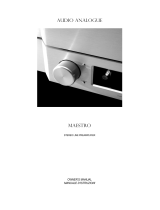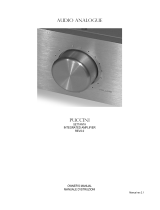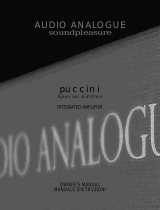
Once all connections have been correctly made (please check twice!), make sure the
volume control is turned completely anticlockwise then turn the unit on by pressing the
power switch on the rear panel. On the front panel, the power indicator will glow red
to indicate that the unit is in standby. After about one second, the unit is ready to operate.
The standby button can now be pressed to exit the standby mode. When the amplifier
exits the standby mode the power indicator turns to green and the amplifier is ready
to receive remote control commands. Using the standby feature, the amplifier may be
left switched on between one listening session and the next, thus giving its best right
from the first few notes. We advise you not to leave the unit always switched on: this
could increase the risk of damage arising from mains survoltages (lightning). If, after
power-up, the power indicator starts blinking red, then a fault in the amplifier circuit or
a short-circuit on the speaker outputs are present. Turn the amplifier off, carefully check
for wrong cable connections on the speaker outputs causing short-circuits and turn the
amplifier on again. If the power indicator still blinks, turn the amplifier off and contact
your Audio Analogue dealer for servicing. Also, if the power indicator remains turned
off after powering the unit, turn the amplifier off and contact your Audio Analogue dealer.
An “intelligent” protection circuit continuously continuously monitors the output current.
The current limit is fairly high, allowing the amplifier to reach the clipping even on a 2
Ohm load. So, during normal listening, the protection circuit is inactive. Light current
overloads are managed reducing the current output, while severe overloads cause the
protection to completely isolate the amplifier, entering the “emergency” mode that can
only be reset by turning the amplifier off. If, during a listening session, should the
protection circuit activate, thus causing the outputs and inputs to be isolated and the
power indicator to blink red, turn the amplifier off, reduce the volume, and then turn the
amplifier on again.
Una volta che tutti i collegamenti sono stati correttamente effettuati (controllare due
volte!), assicurarsi che la manopola del volume sia totalmente ruotata in senso antiorario
e accendete l’apparecchio premendo l'interruttore posizionato vicino alla presa IEC sul
pannello posteriore. Sul pannello anteriore, l’indicatore di alimentazione si accenderà
di rosso per indicare che l’apparecchio è in stand-by. Dopo circa un secondo, l’unità
è pronta per il normale funzionamento. E’ possibile ora premere il pulsante “standby”
per attivare l’amplificatore. Quando l’amplificatore esce dallo standby il led di accensione
diventa verde e l’unità diventa sensibile ai comandi impartiti tramite il telecomando.
Benché già musicale al momento dell'accensione, l'amplificatore raggiunge il massimo
delle sue prestazioni sonore dopo un periodo di "riscaldamento". Utilizzando la funzione
di standby, potrete lasciare l'amplificatore in funzione tra una sessione d'ascolto e l'altra,
ottenendo cosi sempre il massimo sin dalle prime note d'ascolto. Sconsigliamo comunque
di lasciare l'apparecchio sempre acceso; in questa maniera, infatti, si aumenta la
possibilità di danni derivati da sovratensioni sulla rete di alimentazione (fulmini). Se,
dopo il power-up iniziale, l’indicatore di alimentazione dovesse lampeggiare in rosso,
allora si è verificato un guasto nell’amplificatore o è presente un cortocircuito sulle
uscite degli altoparlanti. Spegnete l’amplificatore, controllate le connessioni dei cavi
dei diffusori e riaccendete l’amplificatore. Se l’indicatore di alimentazione lampeggia
ancora, spegnete l’amplificatore e contattate il vostro rivenditore Audio Analogue per
un intervento. Se, all’accensione dell’apparecchio, l’indicatore di accensione dovesse
rimanere spento, contattate il vostro rivenditore Audio Analogue. Un circuito “intelligente”
di protezione controlla continuamente la corrente di uscita dell’amplificatore. Il limite
di corrente è decisamente elevato, e permette di raggiungere il clipping anche su un
carico di 2 Ohm. Così, durante un normale ascolto le protezioni rimangono inattive. I
leggeri sovraccarichi sono gestiti limitando la corrente in uscita, mentre i sovraccarichi
più pesanti vengono evitati scollegando le uscite dei diffusori e tutti gli ingressi, ed
attivando il modo “emergenza” che può essere disattivato unicamente spegnendo e
riaccendendo l’amplificatore. Se, durante una sessione di ascolto, si dovessero attivare
le protezioni con l’attivazione del modo “emergenza”, spegnete l’amplificatore, abbassate
il volume e riaccendete l’amplificatore.
OPERATION
FUNZIONAMENTO
11






















